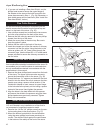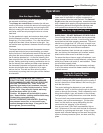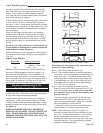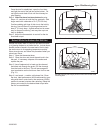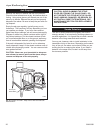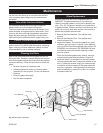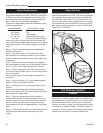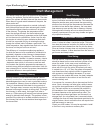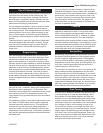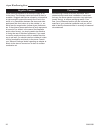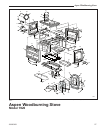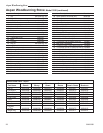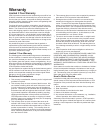
24
Aspen Woodburning Stove
30000369
Your stove is only one part of a system that includes the
chimney, the operator, the fuel and the home. The other
parts of the system will affect how well the stove works.
When there is a good match between all the parts, the
stove works well.
Wood stove operation depends on natural (unforced)
draft. Natural draft occurs when exhaust gas is hotter
(and therefore lighter) than the outdoor air at the top
of the chimney. The greater the temperature differ-
ence, the stronger the draft. As the hot exhaust gas
rises out of the chimney it generates suction that draws
air into the stove for combustion. A slow, lazy fire with
the stove’s air inlets fully open indicates a weak draft.
A brisk fire, supported only by air entering the stove
through the normal inlets, indicates a good draft. The
inlets are passive; they regulate how much air can enter
the stove, but they do not move air into it.
The efficiency of a modern woodburning appliance,
(in which the amount of air available for combustion is
regulated), depends on the chimney to keep exhaust
gases warm all the way outdoors. The characteristics
of your chimney - whether it is steel or masonry, interior
or exterior, matched or mismatched to the stove collar
- determine how quickly it will warm up and how well
it will sustain the optimum temperatures necessary to
maintain strong draft and efficient combustion. Here fol-
lows a description of various flue system characteristics
and related effects on stove performance.
Masonry Chimney
Although masonry is the traditional material used for
chimney construction, it can have distinct performance
disadvantages when used to vent a controlled-combus-
tion woodstove. Masonry forms an effective ‘heat sink’
- that is, it absorbs and holds heat for long periods of
time. The large mass, however, may take a long time to
become hot enough to sustain a strong draft. The larger
the chimney (in total mass), the longer it will take to
warm up. Cold masonry will actually cool exhaust gases
enough to diminish draft strength. This problem is com-
pounded if the chimney is located outside the home or if
the chimney flue has a cross-sectional size larger than
the stove outlet.
Steel Chimney
Most factory-made ‘Class A’ steel chimneys have a
layer of insulation around the inner flue. This insulation
keeps the smoke warm and protects the surrounding
structure from the high flue temperatures. Because the
insulation is less dense than masonry, the inner steel
liner warms up more quickly than a masonry chimney.
Although steel chimneys are not as attractive as their
masonry counterparts, they are very durable and gener-
ally outperform masonry.
Inside/Outside Location
Because the chimney’s function is to keep the smoke
warm, it is best to locate it inside the house. This loca-
tion uses the house as insulation for the flue and allows
some radiant heat release from the flue into the home.
Since an interior chimney does not continuously lose its
heat to the outdoors, it takes less heat from the stove to
get it warm and keep it warm.
Flue Sizing
The flue size for a controlled-combustion appliance
should be based on the cross-sectional volume of the
stove flue outlet. In this case, more is definitely not
better. Hot gases lose heat through expansion; if a
stove with a six-inch flue collar (28 square inch area)
is vented into a 10” x 10” flue, the gases will expand to
over three times their original volume. As gases cool
with expansion, draft strength decreases. If an over-
sized flue is also outside the house, the heat it absorbs
will be conducted to the outdoor air and the flue will
remain relatively cool.
It is common for a masonry flue to be oversized for the
stove. Such a chimney can take quite a while to warm
up and the stove performance will likely be disappoint-
ing. The best solution to an oversize flue problem is
the installation of an insulated steel chimney liner of
the same diameter as the appliance flue outlet. The
liner keeps the exhaust gas warm and the result is a
stronger draft. An uninsulated liner is a second choice
- although the liner will keep the exhaust restricted to its
original volume, the air around the liner will require time
and heat energy to warm up.
Check your local codes. You may be required to install
a flue liner in any oversize or masonry flue.
Draft Management



